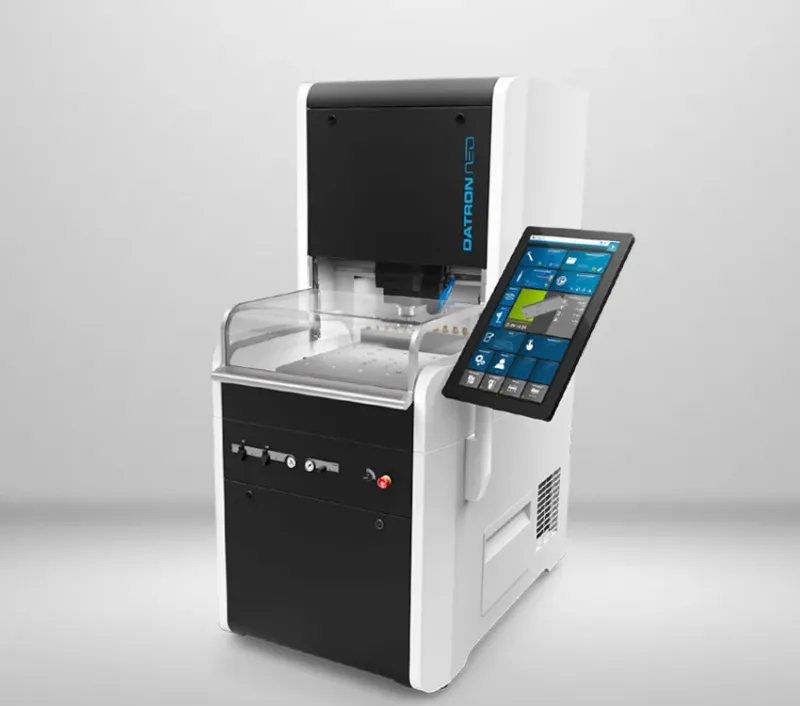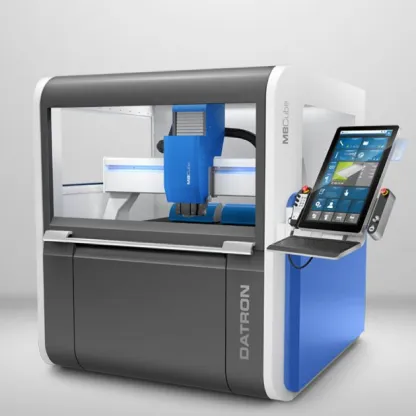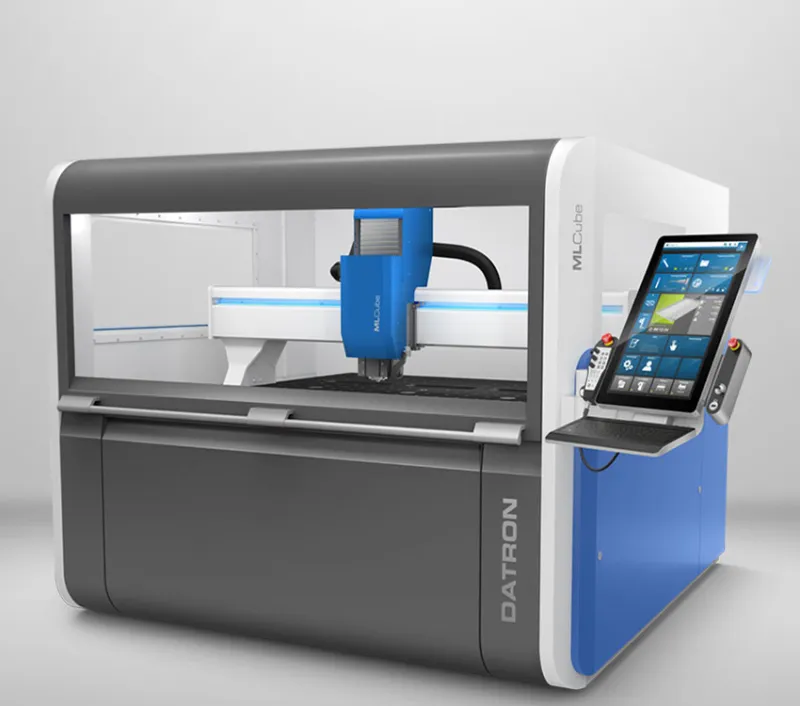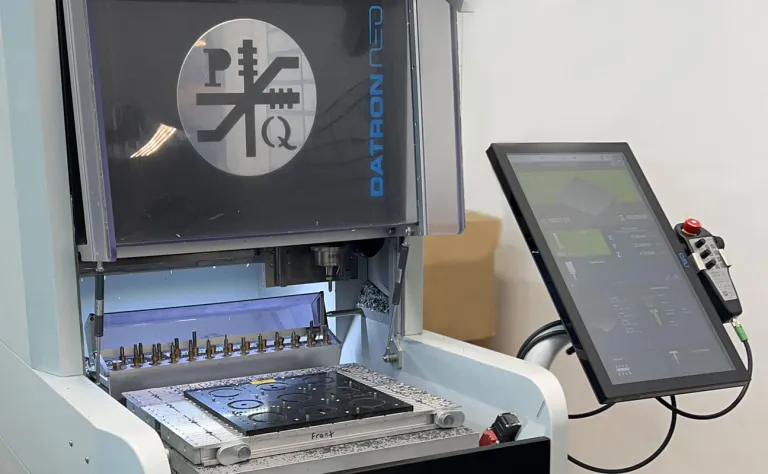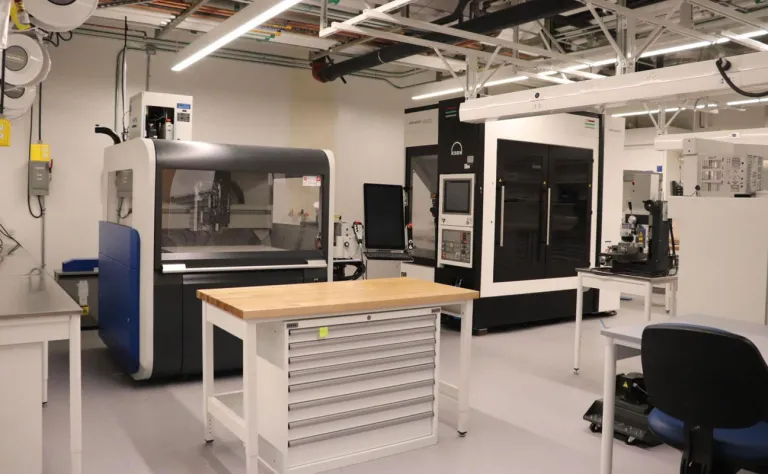 Integrating the DATRON neo into the Engineering Curriculum
Integrating the DATRON neo into the Engineering Curriculum
The University of Maryland’s Terrapin Works is an advanced manufacturing facility within the College of Engineering. It provides production services and experiential learning opportunities for students. Terrapin Works offers rapid prototyping, advanced manufacturing, and digital design services. With over 28,000 square feet of lab space, it supports a wide range of projects, from student prototypes to industrial-grade manufacturing.
Since 2018, David Kriesberg has been the Instructional Shop Manager for the Instructional Fabrication Lab and Advance Fabrication Lab for the engineering college at the University of Maryland. That same year, the lab acquired the DATRON neo as an addition to its existing equipment, offering a less intimidating and more user-friendly machine for students and researchers alike.
Challenges Faced Before DATRON neo
Before acquiring the DATRON neo, the University of Maryland’s CNC operations were supported by two key machines: an Okuma Genos 460 and a Trak Knee Mill. Since then, the University has also acquired a DMU 50 for industrial machining. These machines presented a steep learning curve for students, particularly the Okuma Genos 460, which required an entire semester of training to operate effectively. This created a skill development gap, as no intermediate machine allowed students to build their confidence before moving from manual operations to industrial machining. The existing machines were either too simplistic or too complex, leaving a significant need for an intermediate solution that was intuitive, easy to use, and efficient.

Why the DATRON neo?
The DATRON neo addressed these needs effectively. When researching CNC machines, the University was drawn to DATRON’s ability to produce high-quality finishes easily, making it a valuable solution for both research and education.
“We were looking for something that was a lot more friendly to utilize, and that’s where we had DATRON come in mind. It had a big display, and a lot of manual operations that you can do on the fly right there,” noted Kriesberg.
The neo’s user-friendly design, combined with its advanced features, provided a balance between accessibility and precision needed for their educational goals. Several key features made the DATRON neo stand out:
Vacuum table: Terrapin Works’ key selling point was the vacuum table. DATRON’s vacuum tables ensure precision part-holding, which is essential for intricate projects. The secure hold prevents part movement during high-speed machining, leading to higher accuracy and reduced rework.
User-friendly interface: The neo’s intuitive touchscreen display, advanced probing capabilities, and streamlined controls make it highly accessible for students, even those with little CNC experience. The ease of programming and operation allows students to focus on mastering design and fabrication rather than troubleshooting complex machine controls.
High-speed machining: Operating at up to 40,000 RPM, the DATRON neo offers exceptional precision and smooth surface finishes at a high speed, enabling rapid prototyping and production of complex parts. This is especially valuable in a university setting, where fast turnaround and accuracy are crucial for project deadlines and iterative design processes.
Compact footprint: The neo’s small size allows it to fit seamlessly within the lab’s space constraints without sacrificing performance. This was an essential factor for the University of Maryland lab, where optimizing workspace while maintaining access to cutting-edge manufacturing technology was a priority.
Versatility for various materials: The University lab deals with various materials, ranging from soft metals like aluminum to advanced plastics. The DATRON neo’s ability to machine a wide range of materials precisely made it a highly versatile tool for their diverse projects.
Ultimately, the DATRON neo bridged the gap between advanced machining capabilities and user accessibility, empowering the next generation of engineers at the University of Maryland. The DATRON neo became a stepping stone between the manual hybrid machines and the industrial CNCs like the Okuma.

Implementation & Use in the Curriculum
From the start, the DATRON neo was integrated into research projects and student education. While student staff primarily use the machine, researchers can access it for specific projects. Terrapin Works emphasizes hands-on learning, allowing students to take the lead in running the machine for their competition teams, research, and coursework.
Training on the DATRON neo began with simple tasks like engraving nameplates but has since progressively evolved into more complex projects. For example, students now create coasters using various fixturing techniques (vacuum table, soft jaws, etc.), forcing them to experiment with different setups for each coaster. Each project builds on the last, enhancing the students’ understanding of fixturing, speeds, and feeds.
When speaking with Kreisberg, he noted that, “Overall the machine is fortunately not intimidating as opposed to a manual machine or mill, somewhere they have to do programming with the coding. It may be because of the giant screen that makes sense, but the students learn quickly and are emboldened to use it.”
The lab developed a curriculum hosted on two online platforms: Tzuki, which includes guides for machine operations, and Canvas, an online course platform. These platforms provide detailed step-by-step instructions on project setup, maintenance, and troubleshooting. With the help of machine specialists, who are also student staff members, new users are walked through their projects up to the cutting phase, ensuring a comprehensive learning experience.

Key Benefits of DATRON neo for the University of Maryland Engineering Department
1. Ease of Use: The intuitive interface and touchscreen display allow students to confidently operate the machine, making it a useful teaching tool in the lab. The neo is far less intimidating than the industrial machines, reducing the fear factor for students.
2. Increased Accessibility: The DATRON neo is primarily operated by student staff, who have after-hours access once trained. This flexibility empowers students to take ownership of their projects without needing constant supervision.
3. Bridging the Skill Gap: The neo acts as a bridge between manual and industrial CNC machines. Students learn fundamental machining techniques on the DATRON before progressing to more complex operations on machines like the Okuma.
4. High Utilization: The DATRON neo is the second most used machine in the lab, just behind the small water jet. It has become a staple for student-run projects, especially for those on competition teams such as Battle Bots, and for researchers creating parts for high-precision projects such as chemical-resistant chambers.
Challenges and Solutions
While the DATRON neo has been a helpful addition to the lab, there have been some challenges. This led to increased emphasis on speed and feed training, ensuring students understand the differences between machines like the DATRON neo (with its higher RPM) and other industrial CNCs that have much lower RPMs.
The neo also empowered the University to handle some maintenance tasks in-house, thanks to DATRON’s remote support and the spindle exchange program, which has helped save costs and reduce downtime.
Future Plans
The University of Maryland is eager to continue expanding the use of the DATRON neo beyond aluminum, experimenting with materials like brass and steel. While they feel they are not yet utilizing the machine to its full capacity, they see great potential for its continued role in enhancing student learning and research output.
Conclusion
The DATRON neo has aided in the transformation of the University of Maryland’s engineering curriculum by providing a user-friendly, high-performance CNC machine that bridges the gap between manual and industrial operations. With its intuitive design and powerful capabilities, the neo empowers students to take on increasingly complex projects, ensuring they are well-prepared for modern manufacturing challenges. As Terrapin Works continues to innovate, the DATRON neo will remain a cornerstone of their advanced manufacturing education and research efforts.
David Kriesberg and His Role at Maryland University
 David Kriesberg serves as the Instructional Shop Manager for the Instructional Fabrication Lab and Advance Fabrication Lab for the engineering college at the University of Maryland. Mr. Kriesberg received his B.S. degree in Mechanical Engineering from University Maryland, and his M.E. degrees in Mechanical Engineering from the University of Maryland.
David Kriesberg serves as the Instructional Shop Manager for the Instructional Fabrication Lab and Advance Fabrication Lab for the engineering college at the University of Maryland. Mr. Kriesberg received his B.S. degree in Mechanical Engineering from University Maryland, and his M.E. degrees in Mechanical Engineering from the University of Maryland.
*The University of Maryland selects equipment based on specific educational and research needs, and does not endorse one product over another.
Education & Research
The University of Maryland’s Terrapin Works is an advanced manufacturing facility within the College of Engineering.
The University of Maryland faced a challenge in bridging the skill gap between manual and industrial CNC operations, as their existing machines were either too simplistic or too complex, leaving students without an intuitive, intermediate solution for building confidence.
